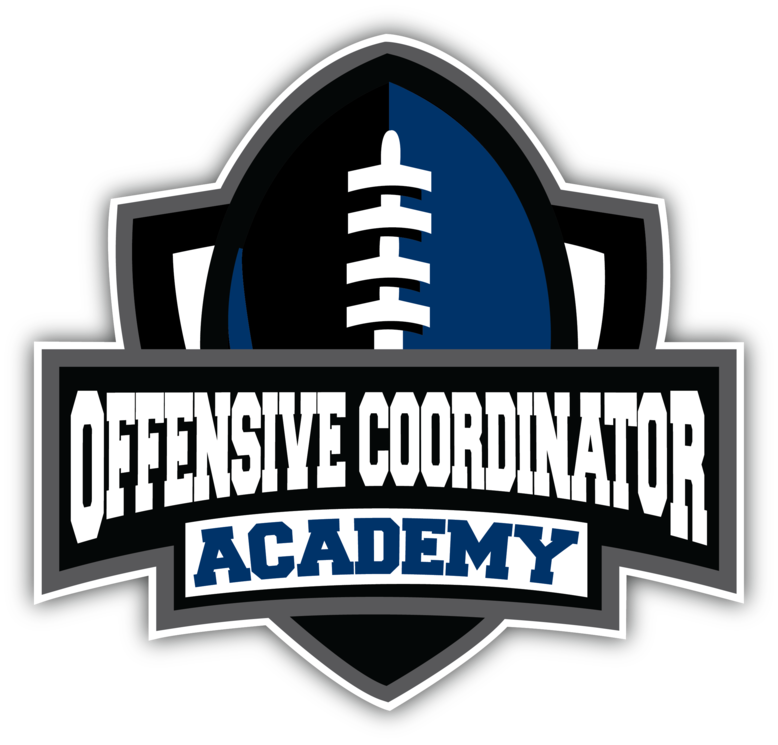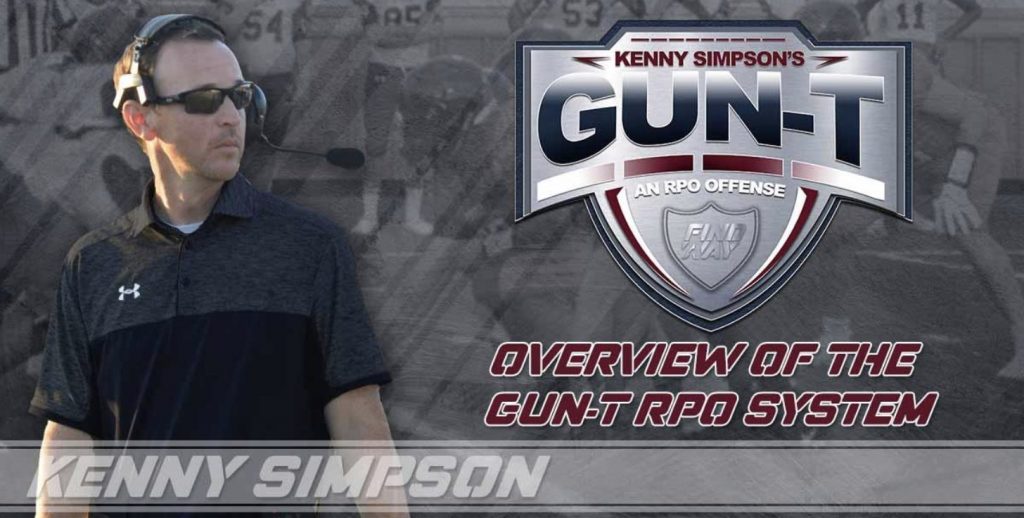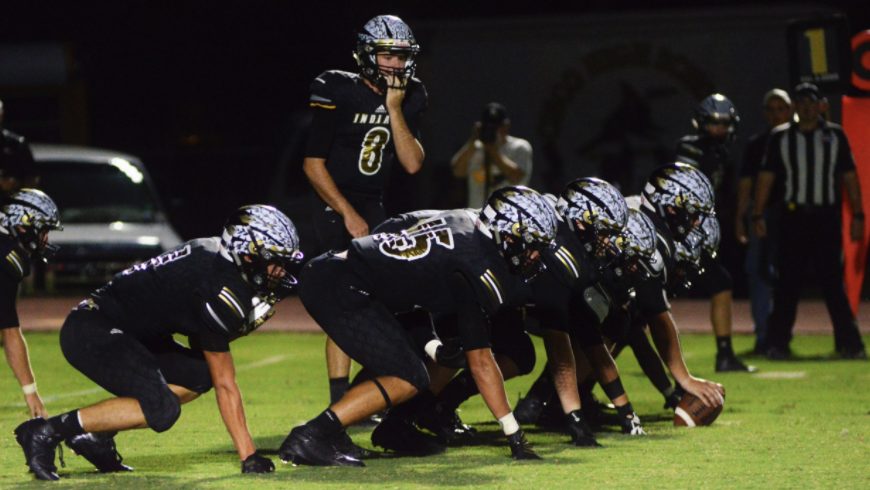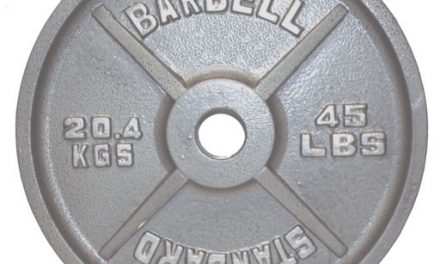We are a Wing T, gap scheme offense, and use a lot of pin and pull in our run game. We work most of our base runs and teach our offensive linemen the same way we teach our WRs in the passing game. One season I realized that our linemen had no idea where the ball was going and what their main goal was. All they knew was to block down or pull. Making in-game adjustments was a nightmare.
Check Out Coach Simpson’s Offensive Coordinator Academy

From this point on, we wanted each of our players to understand the concept of each run play. If they understand they may “get beat”, but simply can’t “get beat” to one side or the other, they are able to block much more effectively. This also should minimize those terrible “away from the play” flags that drive coaches crazy. We teach a backside lineman that even though all blocks are important, the probability of a backside defensive player, who is already beat by alignment, making the play is very low. Don’t ever hold on the backside of a play.
In high school football, the offensive line is the difference between wins and losses. We want our linemen to know not only the scheme, but how teams will attack it and how to answer those attacks, so we start with letting them know the basic play. Here is a Buck Sweep from our basic Wing T set.
BASE BUCK SWEEP
After teaching the basic rules and play, we work very hard to teach each position their base blocks and drill the fundamentals every day. We work the blocks we will use most by each position at the same proportion they will use it — for example, a Strong Tackle in our offense will more than likely never pull, so he never works that in Individual time (he would double up on down blocking).
In the Wing T, fundamentals are a must! Do not neglect to teach your guys the blocks they will use and the footwork they need. More importantly, don’t forget to explain to them how the drill goes into the scheme.
Oftentimes I’ve seen offensive line coaches work all their players equally on each block, and this is fine for some blocks or schemes. But in the Wing-T, we have linemen that are created differently and need to be used in different ways in our offensive scheme.
For example, we work our Offensive Line Wing T drills equal time to the type of block expected:
1) If this lineman is down blocking 50% of the time, we want that dedicated in individual time.
2) If we want this lineman to cut block 20% of the time, we will work that also.
3) If this lineman is our main puller, we want to work this the majority of his individual time.
Oftentimes teams feel they must do a lot of “group” or “team” to accomplish this. I would much rather coach them up with 1 coach and a smaller group, and then bring it together for a shorter amount of time. We try to only run 10-12 plays during inside drill and 10-15 plays (pretty much all scenario work or motions/shifts) during team periods. Once the line understands the scheme and they know how to execute blocks, making adjustments in games are much more simple.
After working the fundamentals and base blocking, we start to go over scenarios they may see against the Wing T. We don’t take time to go over each and every situation, but use our rules as a base and give them potential problems they would see and how to handle them. We work out how to “get beat” and still accomplish the block (an example would be if you have to give up penetration be sure to turn defender inside). Make sure your line knows where the ball should go on all plays. Don’t ever assume they know or understand.
Once the linemen all understand what we expect on each play, we begin to work tags for our reads and different ways to block at the point of attack. Here is an example of buck sweep again if we simply make the call for Buck (or in our offense some other words).
BYPASS
Here it is with our line making an adjustment (“Bypass” for our wing).
This is a simple line call when we are having issues with a very talented nine-technique inside our wing. Instead of abandoning the concept, we adapt the play and our athletes understand how it can look different.
We want to give our linemen the freedom to communicate at the line of scrimmage and make the correct calls so that they can get the defense blocked. If they understand what we are attempting to accomplish, they are able to make many adjustments on their own and can tell the coach why a play is not working. Many times, we’ve simply listened to what the linemen were suggesting — For example a double team vs a free release — and have made that adjustment in-game, or even in the middle of a drive.
Buck Sweep RPO Concepts
We also marry each of our runs with our RPO concepts. Pretty much, we run all our RPO game through who the backside tackle blocks. He has 3-4 calls that tell him who to block and the QB who to read. This again allows one run to look like 10 different ones and when you combine RPO reads it grows to many more.
Here are just a few tags we put with this base run that make our linemen’s job much easier.
STEAL
The only player that needs to know anything about this is our backside tackle. This simply tells him to block the outside most defensive player, and our QB will read the defensive linemen.
Very easy adjustment for us to make against teams that are trying to take away buck sweep with the backside defensive tackle/end.
FAST or NOW
The only players that need to know how this works are the WRs. Most teams already run this and it is a simple compliment to any run on the backside.
This is the simplest RPO we have in our offense and is usually a day 1 installation for us. We simply teach pre-snap leverage. Many teams run a similar concept and we like it because it forces the defense to become more balanced and defend the entire field.
KEY
This tells our QB to read the backside inside linebacker. It is a very easy read for the QB and requires no time for the offensive line.
This is another simple adjustment for us to read another player on the defense. Our goal is to always have built-in answers to any concept in our running game. The last thing we want to do is be forced to abandon our favorite run play and this gives us one more adjustment.
PEEK
We work this concept with our inside WRs on-base passes as well, but then we often tag it with a run going the other direction. Many teams are running this simple concept. The QB reads the backside inside linebacker and throws the “peek” route or gives for the run. One thing we have always taught is that if the QB misses the read and pulls the ball, then he should run to where the play was designed to go.
We put this in due to having a QB that was not as talented a runner, but was able to throw a very accurate ball and we wanted to still read the same player on the defense. Another simple concept for our WRs. We actually will run this same pass concept in other plays.
STOVEPIPE
Another simple term that only the backside tackle needs to know. This tells him to ignore the backside defensive end,, and try to climb to scoop a 2nd level player. The QB then will read the backside defensive end.
Pretty self-explanatory read for our offense. It is just one more way to make sure we have answers to what the defense may bring.
Conclusion
This seems overwhelming at first, but when you marry it to your system, the only people that actually need to know all the checks are the QB and the Coach. The players understand a few key terms, and that allows you to make adjustments quickly and in the middle of a game if needed. You can ONLY do this if you are putting in very few actual “plays”.
Thank your for your time and hopefully I was able to help you better run and understand the advantages of the Wing-T.
-Coach Kenny Simpson
If you want to see more of Coach Simpson’s Wing T and RPO system, check out his courses here on CoachTube:




